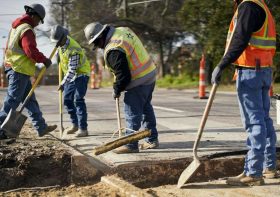Faith and Hard Work In Construction Industry’s

1) Skill shortages and an aging workforce
For the past few years, skill shortages have been a serious issue in the construction business. According to a study conducted by the University of Dundee (2019), the largest age group in the construction industry is 45–54 years old, with the second-largest age group, 35–50 years old, accounting for 22% of all workers.
Many of these employees will eventually retire, making recruiting new, younger talent difficult. The Construction Industry Training Board (CITB, 2018) found that the construction industry’s overall appeal as a career option had dropped to only “4 out of 10 among 14 to 19-year-olds,” and the Union of Construction, Allied Trades and Technicians (UCATT) reported a 14.6 percent drop in construction apprenticeship numbers the same year.
The decline in younger talent has significantly impacted the sector throughout the years, as critical trade skills are lost as people retire. This is a persistent issue in the construction business, which has been widely recorded as a negative perception of what it’s like to work in the industry among younger people. Construction’s negative reputation is attributed to a lack of gender diversity, long hours, low pay, and insufficient job security, according to the Construction 2025 research.
2) Safety and Health
Another major issue in the industry is health and safety concerns and how a lack of adequately qualified staff can have huge commercial consequences, such as a terrible industry image and severe financial loss.
According to HSE construction statistics from 2019, construction has the largest number of health and safety-related accidents in the United Kingdom. Due to a lack of equipment compliance, training, and safety protocols and procedures. According to the same year’s Labor Force Survey data, younger workers aged 16–24 have a significantly higher risk of occupational injury (37 percent higher) than older workers.
From continuing site training to up-to-date PPE to monthly compliance checks, there are numerous aspects of health and safety compliance that must be maintained. Many construction organizations manage these procedures manually rather than through digitalized systems, which means that training and routine maintenance checks may be overlooked, leaving the company open to costly mistakes. Regulatory authorities, for example, may slam businesses with severe fines if they forget to renew a mandated Health & Safety accreditation.
3) Gender balance in the workplace
With men accounting for 99 percent of workers on construction sites (CIF, 2018), there has long been a perception that the construction business is not a good fit for women. A traditional image of a construction site is one populated by macho construction workers who are bigger and stronger than women and those who are naturally driven to physical labor.
This, on the other hand, could not be more out of date. The construction business offers many opportunities, from construction software to design and even architecture. Employees do not have to work on the construction aspects themselves to be involved.
So, why are there so few women in the field, and what can businesses do to change that? Advertising is one technique to get around this. As an industry, we must overcome the stereotype that “construction is for men.” The issue stems from the industry’s present perception and the failure of course providers and companies to attract women.
When it comes to advertising for construction jobs, the photographs and videos and even the wording used in the job descriptions might be gender-specific. Businesses must recognize this and seek out recruitment partners that can help them diversify their workforce by advertising in the appropriate tone of voice and displaying the breadth of opportunities available in the industry.
4) Adoption of new technology
While technological innovation is rapidly progressing, the construction industry is trailing behind the rest of the country, with productivity levels lagging behind every other industry sector (Plangrid, 2018). The government is already aware of this, having introduced a series of programs last year to assist the industry in adopting newer technologies and increasing efficiency.
However, many construction companies struggle to invest in or deploy new technology, so it’s no surprise that construction is the world’s second least digitalized sector, according to a McKinsey Globe Institute analysis.
Although the construction industry may believe that applying technical improvements in a physical context has little benefit, embracing digital technology has several secondary help in the building. More efficient use of materials, enhanced health and safety, safer working conditions, and more efficient recruitment processes are just a few advantages.
5) Productivity of employees
High labor productivity is crucial for finishing projects on time in the construction sector. The construction industry’s labor scarcity is a primary source of declining productivity. As the older generation retires, younger, less experienced workers are left to fill the void. Finding and retaining qualified people is critical as construction projects get more complicated and demand for projects remains high (Onsite, 2019).
Many factors have contributed to poor performance, including reliance on public-sector demand, insufficient onboarding processes, and a lack of investment in skill development. While resolving the labor crisis in the UK construction sector is no easy feat, your employees will not be able to be more productive unless they have the necessary skills.
We can help you locate people with the correct capabilities for your organization – those who will fit in with your culture and can be retained with the right skills and training, lowering overall absenteeism.
We all have reasons for loving this strange industry, and we’ve included a few of ours here
1.) You get to make the things that people rely on.
How many other professionals can say, “I helped build that,” pointing to the town’s brand-new hospital? The things you build are important to the people in your community, whether it’s a road, a house, a sewage system, or a school.
2.) A healthy building industry equates to a healthy economy.
The construction industry is inextricably related to the success of the US economy. Construction projects provide jobs, infuse a community with finances and new life, and build the infrastructure that keeps the country going forward.
3.) It’s entirely up to you; your abilities will make it happen.
As you progress through the ranks, you’ll discover new methods to use both your intellect and your hands to accomplish your goals. Pay attention to the individuals who have been in the building industry for decades if you’re fresh to the business. They know what they’re talking about because they’ve been studying, observing, and learning.
4.) You may see the outcomes of your work right away.
Every day at work, you’ll be able to observe how far you and your team have progressed. One of the most satisfying aspects of a construction job is watching progress evolve into a completed project day by day. (We know there are days when it seems like nothing gets done, but let’s focus on the positives for now.)
5.) Every day is different.
Forget about the mundane 9 to 5 cubicle occupations; each building site presents different challenges. With each new project, you’ll be able to mix things up and avoid employment stagnation, leading to burnout.
6.) You get to work as part of a group.
Another way you’ll put your abilities to use on the Jobsite is by working with your team to overcome hurdles and solve difficulties. On construction projects, strong networks arise because everyone on the team relies on one another to get the job done. Yes, some of the people you’ll be working with will irritate you, but you’ll all get the job done at the end of the day.
Building Faith in the community is much needed for a better life.




